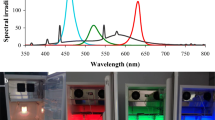Summary
The role of visible light in inducing sporulation in three strains ofAlternaria solani has been studied. The three strains respond differently to sunlight and fluorescent light. The intensity of light, duration of exposure, temperature at the time of exposure and scraping the cultures have a considerable effect on spore yield and spore dimensions. Most effective colour of visible spectrum in inducing sporulation is green.
Similar content being viewed by others
References
Beecher, F. S. 1945. Light and composition of media as factors inducing sporulation in strains ofAlternaria solani. Phytopathology35: 483.
Committee on the Standardization of Fungicidal Tests 1943. The slide germination method of evaluating protectant fungicides. Phytopathology33: 627–632.
Dillon Weston, W. A. R. 1936. The sporulation ofHelminthosporium avenae andAlternaria solani in artificial culture. Trans. Brit. mycol. Soc.20: 112–115.
Gupta S. K. &Pushkarnath 1962. Inducing sporulation in artificial culture ofAlternaria solani (Ell. & Martin) Jones & Grout. Mycopathol. et Mycol. appl.17 82–88.
Houston, B. R. &Oswald J. W. 1946. The effect of light and temperature on conidium production byHelminthosporium gramineum in culture. Phytopathology36 1049–1055.
Johnson, T. W. &J. E. Halpin 1954. Environmental effects on conidial variation in some fungi imperfecti. J. Elisha Mitchell Sci. Soc.70 314–326. Original not seen.
Kunkel, L. O. 1918. A method of obtaining abundant sporulation in cultures ofMacrosporium solani E. & M. Brooklyn Bot. Gdn. Mem.1 306–312.
Lukens, R. J. 1960. Conidial production from filter paper cultures ofHelminthosporium vagans andAlternaria solani. Phytopathology50 867–868.
McCallan, S. E. A. et al. 1941. An analysis of factors causing variation in spore germination tests of fungicides. III. Slope of toxicity curves, replicate tests and fungi. Contrib. Boyce Thomp. Inst.12 49–78.
Pironne, P. P. 1935. An improved method for inducing spore fructification in certain species ofMacrosporium. Phytopathology25 31–32.
Rands, R. D. 1917. The production of spores byAlternaria solani in pure culture. Phytopathology7 316–317.
Author information
Authors and Affiliations
Rights and permissions
About this article
Cite this article
Singh, B.M. Inducing sporulation in different strains of alternaria solani. Mycopathologia et Mycologia Applicata 31, 144–150 (1967). https://doi.org/10.1007/BF02051219
Published:
Issue Date:
DOI: https://doi.org/10.1007/BF02051219




